Insights on InShorts Marketing Strategy with Deepit Purkayastha
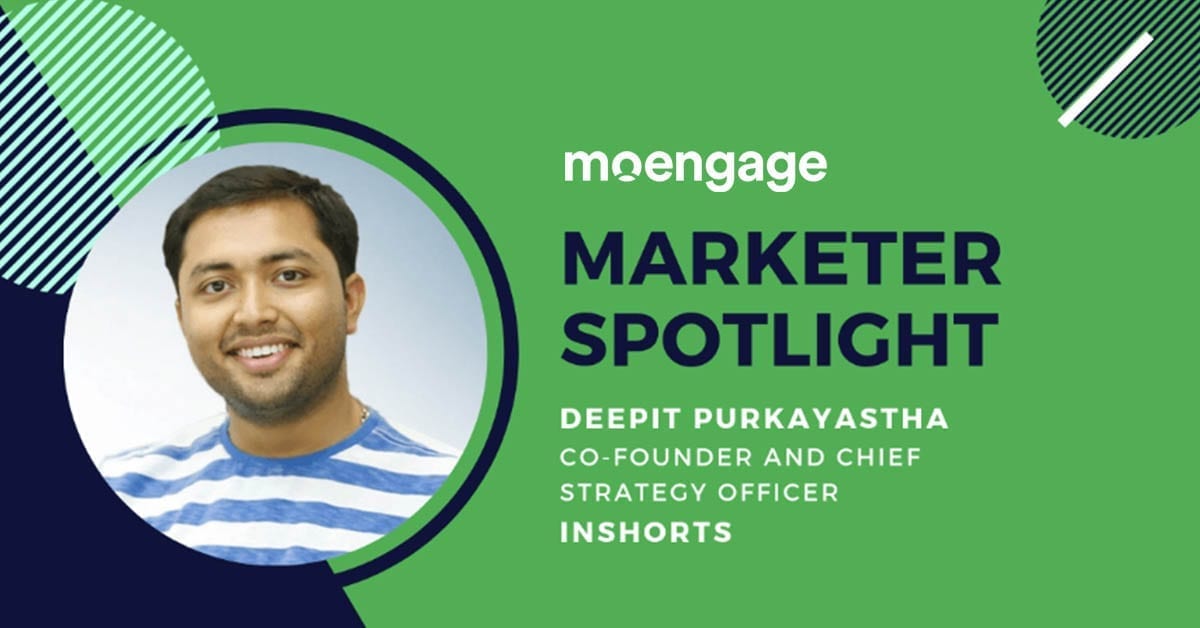
Reading Time: 9 minutes
| Take the Growth Strategy Framework Quiz – Learn how to scale and build a Growth program with this interactive quiz. |
Editor’s Note: Marketer Spotlight is a series of blog interviews focused on sharing insights and best practices from marketing leaders. Deepit Purkayastha, the Co-founder and Chief Strategy Officer of InShorts, shared his insights on what it takes to scale up a news content app in a hyper-competitive market that has an audience with a minuscule attention span.
InShorts is a fantastic success story! Most companies in the content industry focus on growing with virality. However, it doesn’t look like InShorts took that approach.
Deepit: Let me give you a background of how we started. We found that many of our peers were not reading the news, and their primary use case was that they wanted to consume a lot of information in a small amount of time. Facebook was their preferred destination. Twitter had not caught up that much because it was for savvy users who know what they want and customize their feeds according to the information they want to consume. However, for most common users, this was not the case, and Facebook did not satisfy that use case. Facebook mostly carried opinionated, viral content. There was too much opinion but nothing where one could get the facts of the story right. We wanted to fill that gap. We went through many news articles and saw that the amount of content in the first paragraph of the news is enough to inform what is necessary about that story. Rest of it is just increasing words for SEO purposes or adding references. However, the core facts can quickly be boiled down to three sentences, and you can get the circumstances of the story accurately in those three sentences.
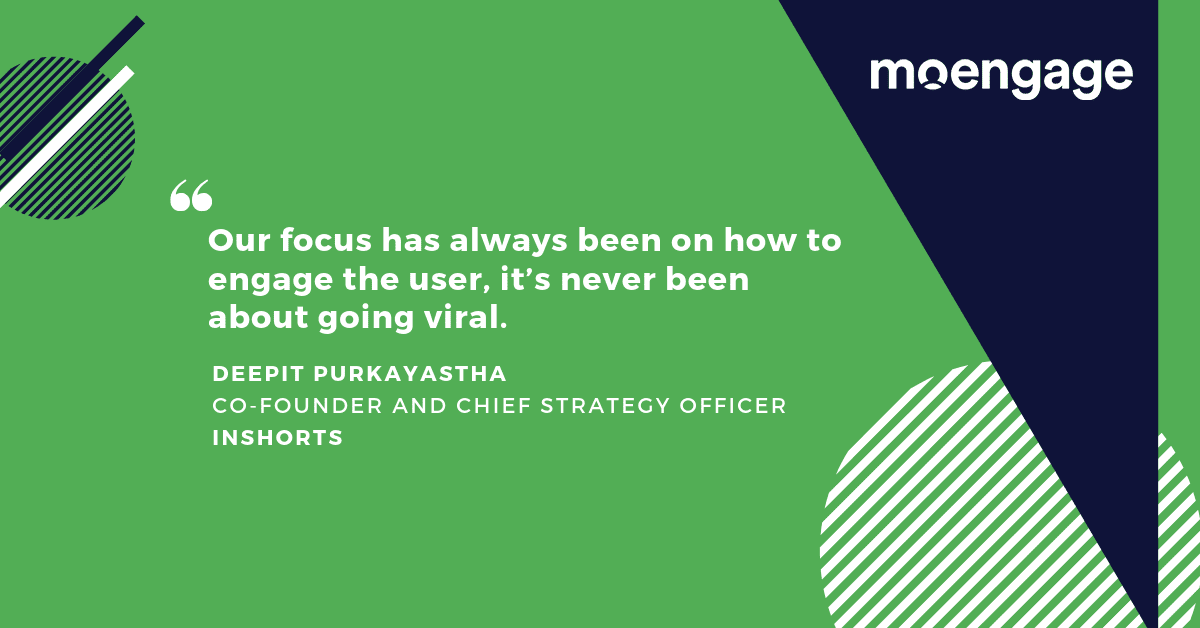
So we built an app where a user can go through 60-word stories, one story at a time without getting diverted or overwhelmed by too many links to click around. We created an experience where the person comes to the app, swipes up, and goes to the next story. We tried to focus on creating the small unit of news experience, which can be consumed throughout the day, anytime, anywhere. For us, the success metric was how many screens did the user go through in a day. Today, the average DAU touches over 80 stories a day! Our focus has always been on how to engage the user, it’s never been about going viral.
Watch Deepit share the InShorts story and how data has helped them pave the pathway to success.
When we last spoke, you mentioned that you have a DAU to MAU ratio of close to 40%, which is fantastic. The content quality plays a role in that. Apart from that, what are some of the main factors that help you drive this level of engagement?
There are 2-3 things that worked well for us. First; we have not focused on the shareability aspect at all. We have always focused on the time spent on the screen. Ultimately, it boils down to what numbers we are measuring and what numbers we are optimizing for. At a unit level, for a particular news story, we estimate how much time the user has spent on that story.
Although the USP we sell to the user is short news, we noticed that the most powerful unit is the image. We did a lot of A/B tests for different kinds of images for the same type of story. The first time the user comes to the screen, the intuitive decision of whether to spend time on the screen or skip is based on the image. For example, if it’s a Facebook story, we run A/B tests to see if Mark Zuckerberg’s headshot is more relevant or the blue Facebook logo. Visual communication is an essential part of our app and we find that users are consuming more and more visual content.
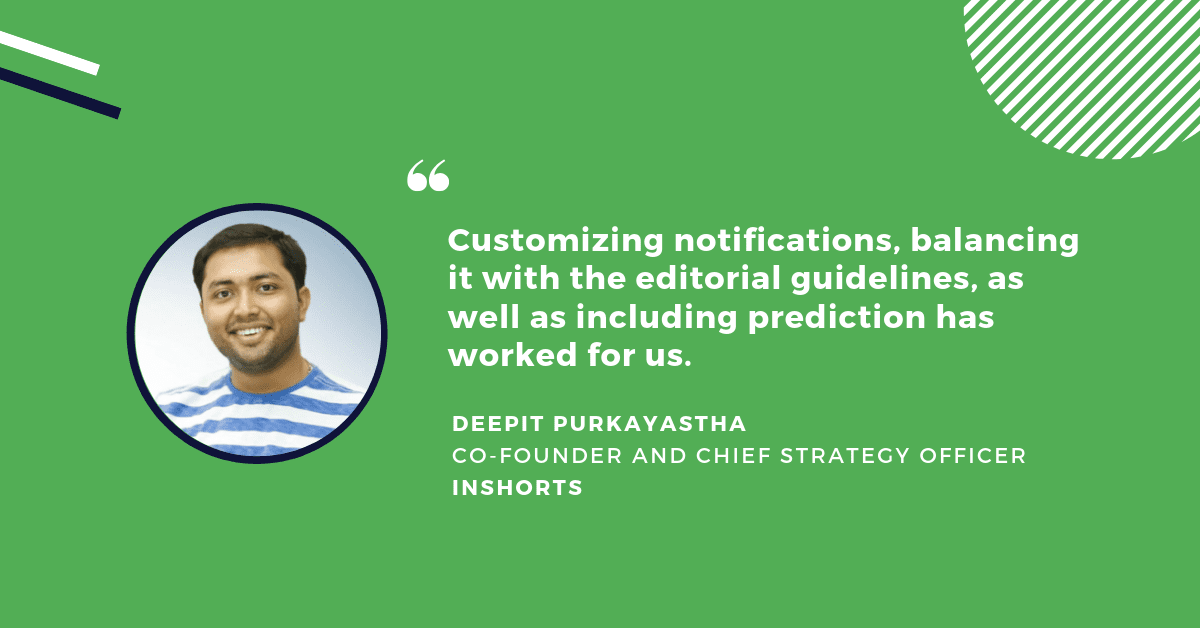
The other metric that has worked for us is to measure the number of screens the user goes through in a single session. Our focus is on that the user comes back to us or consumes stories in a small amount of time, we didn’t want to increase the time spent on the app by increasing the session length. We wanted to increase the time spent on the app by expanding the number of times the user comes back to us. That has worked well and has helped us keep the platform focused and dynamic. It has enabled us to create positive reinforcement in the user’s psyche that every time they come back to the app, they will be able to spend 1-2 minutes of their time learning 6-7 things that are relevant to them.
The third part that has worked well is the relevance of the story. The relevance is a debated topic in the sense that on one side there is personalization, AI, ML kind of a narrative that has captured our imagination but for the news business, it is vital to break the echo chambers that are being built in various platforms that the user is already consuming. We wanted to maintain a balance where you find relevant stories and at the same time, get stories which probably are not entirely of your interest but are of some importance. We have not tried to make the user give clear signals to us, so that reduces the decision point from the user. We track the time users spend on each screen and based on that, have built models that tell us whether the user has liked the story or not. It is based on implicit time data.
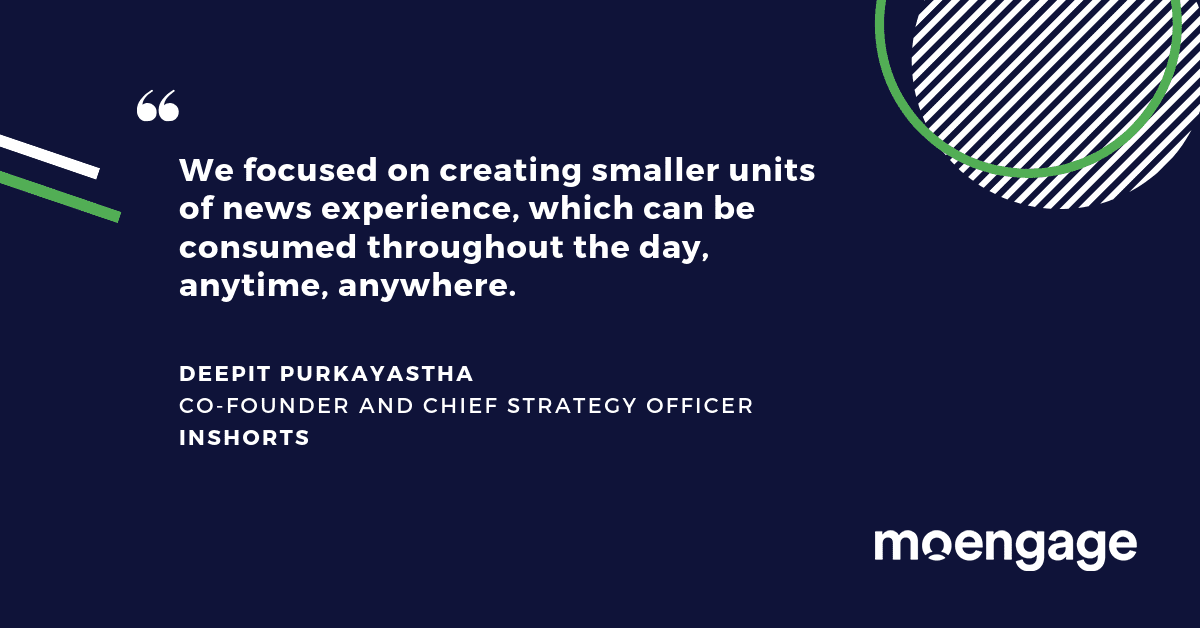
Another thing that has worked for us is notifications. Notifications are a powerful way to engage the user and bring them back to the platform again and again, but it is the most abused tool today because companies tend to spam users with notifications that can lead to app uninstalls. To prevent that uninstall, our editorial team chooses 2-3 stories which are very important and the user should know. Apart from the cap of 2-3 stories a day, we do not publish any more stories as a notification. Beyond this, we publish 30-40 stories a day. We send those additional notifications to only 1% of the users and see whether they like it or not. If it works for them, only then we scale it up to 100% of the users. We also have something called the user interest group. For example, someone might be interested in sports, some in entertainment. So, we scale up based on the target segment. Customizing notifications, balancing it with the editorial guidelines, as well as including prediction; this balance has worked for us.
What has not worked for us is that one time we decided on sending out many notifications. If we were to see the number of DAUs coming to us in the short term, they had increased, but what was also happening was that there was a drop in the retention rate for the users. Spamming using notifications doesn’t work at all.
It looks like there is a lot of data you analyze, which feeds into the rest of the organization, whether it is your editorial or marketing decisions. How is the feedback structured within InShorts?
We are a product business, but at the same time, the product we have is ultimately built around content. Initially, it took us time to channelize our energies on determining our core. For example, should we focus more energy on products and features or whether we should empower our editorial team and content curation team? Eventually, we made the decision because ultimately, we are a content platform, and users come to read the news. We doubled on our existing initiatives and empowered our editorial team with the data which they wanted. So the whole data architecture was structured around them, and the editorial team themselves took the initiative. Even during the initial training and mentoring for new joiners to our editorial team, the training revolves around data, because most of them come from journalism schools. They have a background in summary writing, etc., but they do not have experience in data and data processing. We train them to understand it.
We have also stopped measuring absolute numbers altogether for notifications because total numbers can be dependent on many things. For example, if a notification was sent out at 1 PM today, then within 5 minutes x% of notifications that are delivered will be opened. That number will vary according to the time we send the information. If it is around lunch-time, the open rate is higher. If it is in the middle of the day, the open rate is lower. So, we cannot measure the open rate of notifications sent during lunch with the benchmark based on notifications sent during midday. These things need to be optimized, and the right type of measurement created. We have now started measuring on average benchmarks. Bringing data together during editorial decisions has worked well for us. When you see our editorial team, you will not realize that there is a separate data person or an editorial person. The editors themselves are data-empowered.
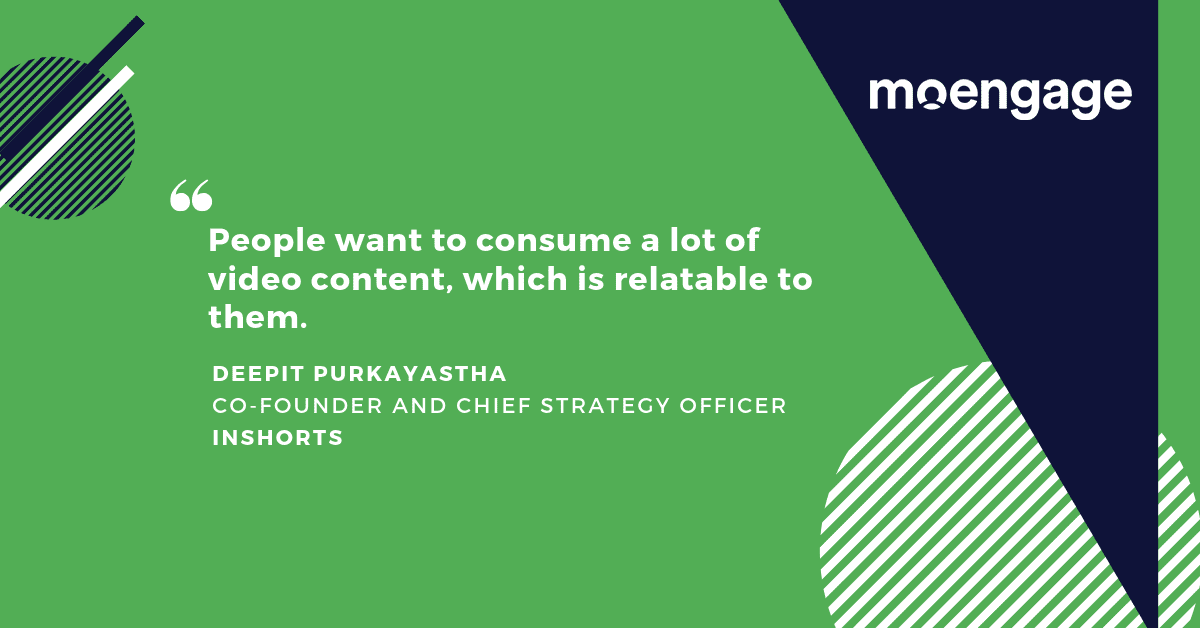
Is that the reason why it helps you to operate at scale?
Yes, our platform is so stable that if we want, we can allow anyone to publish their story and become an editor. It is a self-learning system based on feedback. For example, you can push a story to 0-5% of the users, see how it performs, and then learn from there. Even if there is a churn in the editorial team, it helps us to keep that engine going and making it consistent over time.
Another interesting aspect of InShorts is that you also cater to tier 2 and tier 3 cities in India. How does the audience behavior differ from your observations between these different sets of audience?
The tier 1 cities’ behavior is mirrored into the metro cities kind of behavior. So they are pretty much one class of users. Especially the English speaking users are pretty cosmopolitan and interested in national news. They are familiar with reading short content and are exposed to global apps for the last ten years or so. Once we go outside that demographic, if it is a class B or C in terms of tier 2 cities as well as tier 3 cities, their exposure to the internet, apps, user experience, and product value has evolved within the last 3-4 years. Since it is so recent for them, there is a learning cycle that they are going through. They don’t know how to leverage the internet and the width of what is available. They also do not actively seek things out in most of the categories. For example, most of them have a TV at home, so the news behavior around them is based on TVs, not newspapers. Videos are an engaging source of content for them. Their propensity to consume videos is much higher than the short text. For them, the TV format of news has been quite entertaining, so they consume opinions around news rather than the news itself.
Segmentation can be the pathway to hyper-personalization – here’s how.
When you cater to these different set of audiences, how does the approach differ, and how is it structured within InShorts?
Since the need is so different and the audience classification is so different, we have tried to build a new product itself for that kind of an audience. The opinions and videos were not going well into the core product we had currently. Also, this is a big debate which goes on in many product companies – every product wants to become a super app. Once you try to become a super app, your text and your platform need to have a different kind of robustness and scalability as compared to being a focused app. Scaling value propositions vs. scaling those value propositions in the same app is five times more difficult. To be able to cater to a different audience, one does not need to include it in the same app. We have tried to build a separate app that focuses on videos. Once the user comes to that app, they can see videos, which are crowdsourced from other users and influencers. We are currently experimenting this. For example, a great product that has surged in the market right now is TikTok. TikTok is a massive phenomenon because of the same use case; people want to consume a lot of video content, which is relatable to them. We want to leverage a similar trend but for news and opinion.
Thank you, Deepit, for helping us understand what makes InShorts such a huge success. It was particularly helpful in understanding how companies can disrupt a hyper-competitive market by following the target users and strengthening the core teams to take independent data-driven decisions. We hope to connect with another marketer and touch upon a different aspect of marketing in the next feature.
| Related Articles – |















